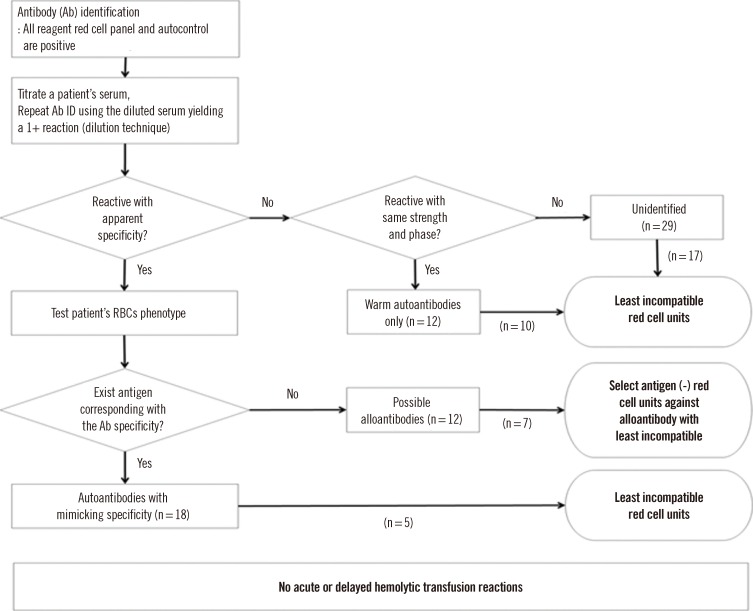Ann Lab Med.
2013 Sep;33(5):343-348. 10.3343/alm.2013.33.5.343.
Autoantibodies with Mimicking Specificity Detected by the Dilution Technique in Patients with Warm Autoantibodies
- Affiliations
-
- 1Department of Laboratory Medicine, Chonnam National University Medical School, Gwangju, Korea. dwryang@chonnam.ac.kr
- 2Department of Laboratory Medicine, Seoul National University Bundang Hospital, Seongnam, Korea.
- 3Department of Pathology, University of Pittsburgh, Pittsburgh, USA.
- KMID: 1781339
- DOI: http://doi.org/10.3343/alm.2013.33.5.343
Abstract
- BACKGROUND
The aim of this study was to investigate the frequency of autoantibodies with mimicking specificity by using the dilution technique, to assess the usefulness of the combination of the dilution technique and red blood cell (RBC) phenotyping, and to establish a pre-transfusion testing algorithm in patients with warm autoantibodies.
METHODS
Serum samples from 71 patients with warm autoantibodies were tested using the dilution technique. Among them, 25 samples were adsorbed with allogeneic ZZAP (a combination of dithiothreitol and enzyme) or polyethylene glycol (PEG) and their RBC phenotypes were determined. Thirty-nine patients were transfused with our pre-transfusion testing algorithm using a combination of dilution technique and RBC phenotyping.
RESULTS
Autoantibodies with mimicking specificity were detected by the dilution technique in 26.8% (19/71) of the patients and most of them were directed against Rh system antigens. The agreement of the results obtained with the dilution technique in combination with RBC phenotyping and those from ZZAP or PEG adsorption was 100% (18/18) in patients who have autoantibodies with mimicking specificity and/or alloantibodies. No clinical symptoms indicating severe acute or delayed hemolytic transfusion reactions were reported in the 39 patients transfused with our pre-transfusion testing algorithm.
CONCLUSIONS
Autoantibodies with mimicking specificity detected by the dilution technique in patients with warm autoantibodies are relatively frequent, can be discriminated from alloantibodies by employing a combination of dilution technique and RBC phenotyping, and might not appear to cause severe acute or delayed hemolytic transfusion reactions.
MeSH Terms
-
Adolescent
Adsorption
Adult
Aged
Aged, 80 and over
Algorithms
Antibody Specificity
Autoantibodies/*blood
Child
Erythrocytes/cytology/metabolism
Female
Humans
*Indicator Dilution Techniques
Isoantibodies/blood
Male
Middle Aged
Phenotype
Polyethylene Glycols/chemistry
Temperature
Young Adult
Autoantibodies
Isoantibodies
Polyethylene Glycols
Figure
Cited by 1 articles
-
Pre-transfusion Testing Using Crossmatching Agglutination Reaction Grades Combined With Rh Subgroup Phenotyping in Patients With Autoantibodies: A Three-year Experience at a Tertiary Hospital
Jongmin Kim, Kyung-Hwa Shin, Hyerim Kim, Hyung-Hoi Kim, Hyun-Ji Lee
Ann Lab Med. 2023;43(5):470-476. doi: 10.3343/alm.2023.43.5.470.
Reference
-
1. Leger RM, Garratty G. Evaluation of methods for detecting alloantibodies underlying warm autoantibodies. Transfusion. 1999; 39:11–16. PMID: 9920161.
Article2. Øyen R, Angeles ML. A simple screening method to evaluate the presence of alloantibodies with concomitant warm autoantibodies. Immunohematology. 1995; 11:85–87. PMID: 15447065.
Article3. Cid J, Ortín X, Pinacho A, Parra R, Contreras E, Elies E. Use of polyethylene glycol for performing autologous adsorptions. Transfusion. 2005; 45:694–697. PMID: 15847656.
Article4. Branch DR, Petz LD. A new reagent (ZZAP) having multiple applications in immunohematology. Am J Clin Pathol. 1982; 78:161–167. PMID: 6808844.
Article5. Branch DR, Petz LD. Detecting alloantibodies in patients with autoantibodies. Transfusion. 1999; 39:6–10. PMID: 9920160.6. Dwyre DM, Clapper A, Heintz M, Elbert C, Strauss RG. A red blood cell autoantibody with mimicking anti-E specificity. Transfusion. 2004; 44:1287–1292. PMID: 15318850.
Article7. In : Carson TH, editor. Pretransfusion testing of patient blood. Standards for blood banks and transfusion services. 27th ed. Bethesda: American Association of Blood Banks;2011. p. 33–35.8. Kim KH, Kim KE, Woo KS, Han JY, Kim JM, Park KU. Primary anti-D immunization by DEL red blood cells. Korean J Lab Med. 2009; 29:361–365. PMID: 19726900.
Article9. Petz LD, Garratty G, editors. Immune hemolytic anemias. 2nd ed. Piladelphia: Churchill Living stone;2004. p. 375–400.10. Fundenberg HH, Rosenfield RE, Wasserman LR. Unusual specificity of auto-antibody in auto-immune hemolytic diseases. J Mt Sinai Hosp N Y. 1958; 25:324–329. PMID: 13564182.11. Issitt PD, Combs MR, Bumgarner DJ, Allen J, Kirkland A, Melroy-Carawan H. Studies of antibodies in the sera of patients who have made red cell autoantibodies. Transfusion. 1996; 36:481–486. PMID: 8669076.
Article12. Wheeler CA, Calhoun L, Blackall DP. Warm reactive autoantibodies: clinical and serologic correlations. Am J Clin Pathol. 2004; 122:680–685. PMID: 15491963.13. Garratty G. What do you do when all units are incompatible? Rev Med Inst Mex Seguro Soc. 2005; 43(S1):107–111.14. Yun HK, Cho D, Chae MJ, Jeon MJ, Suh SP, Ryang DW. No hemolytic transfusion reactions in a patient with the apparent anti-e autoantibody following transfusion of packed red cells with CcDEe phenotype. Korean J Blood Transfus. 2007; 18:116–120.
- Full Text Links
- Actions
-
Cited
- CITED
-
- Close
- Share
- Similar articles
-
- Auto-antibody Showing Anti-Fy(b) Specificity as Proven by the Dilution Method in the Presence of Warm Autoantibodies: A Case Report
- A Case with Changes in Autoantibodies with Mimicking Specificity in a Patient with Hepatocellular Carcinoma
- Red Blood Cell Autoantibodies in Patients Treated with Immune Checkpoint Inhibitors
- A Pemphigus Vulgaris with IgG1 and IgG4 Subclass Autoantibodies
- Current Concept of Anti-limphocyte Autoantibodies


